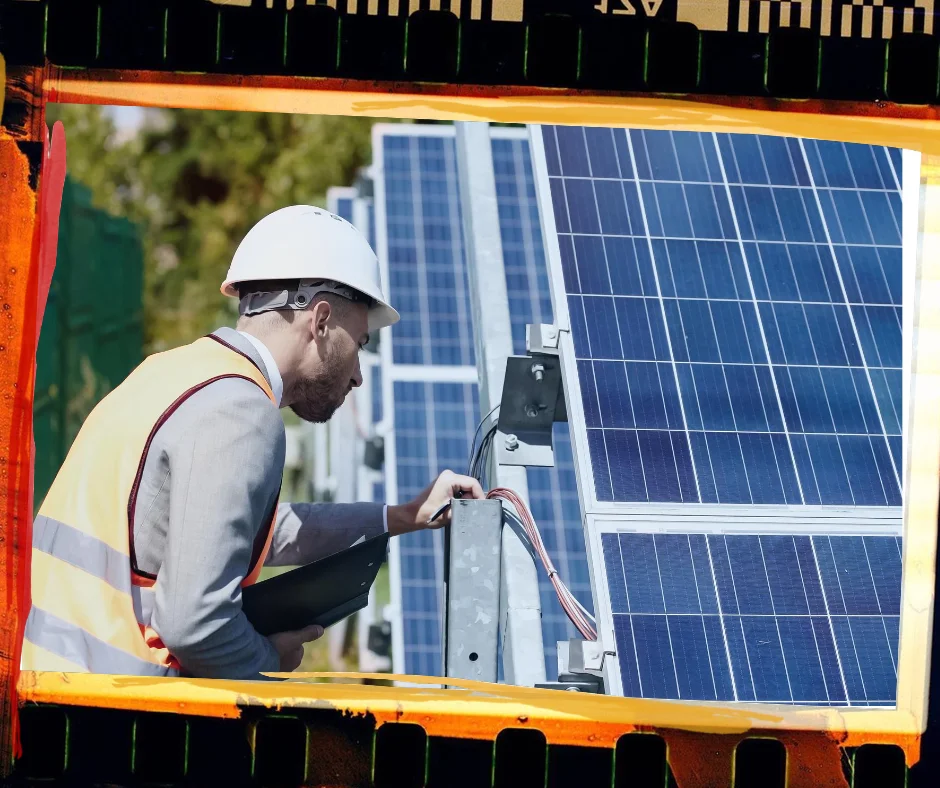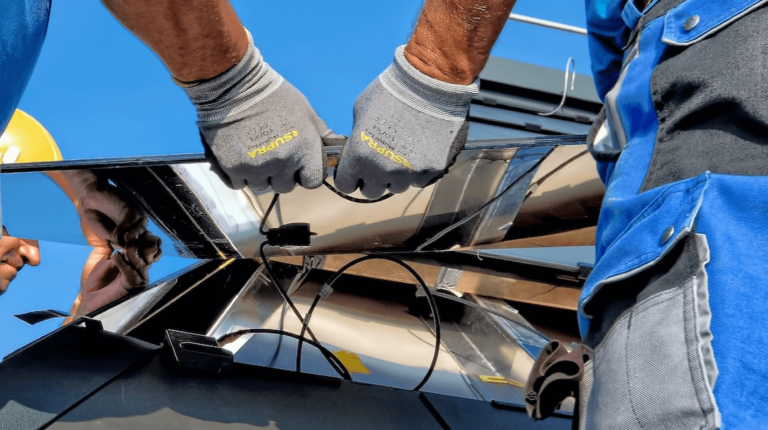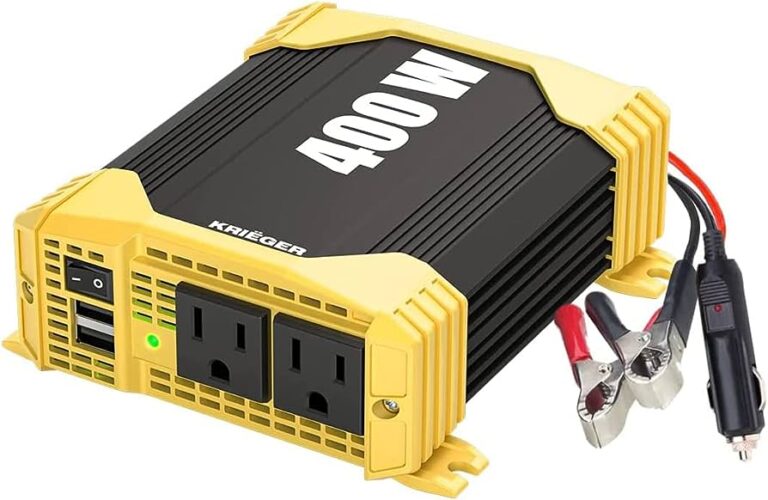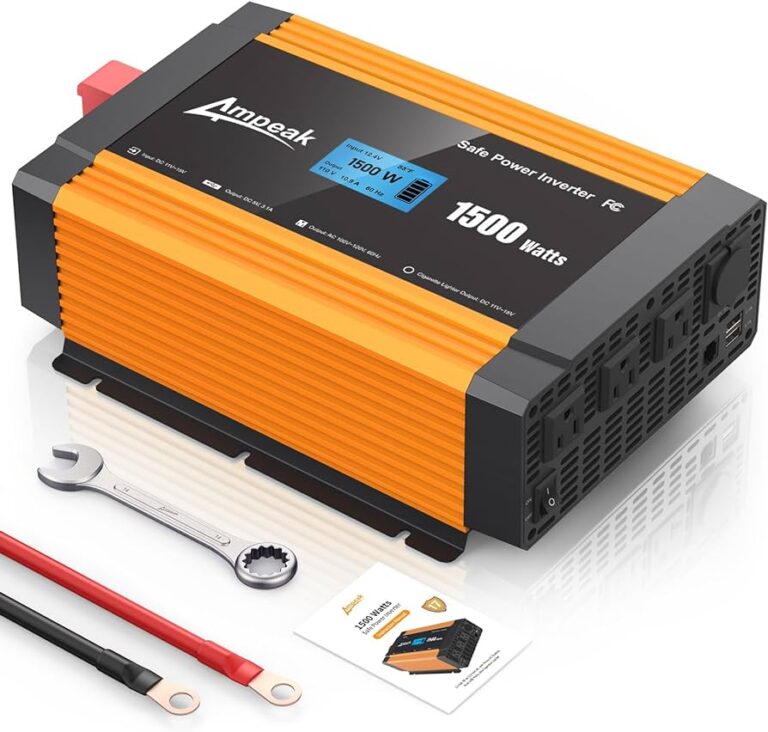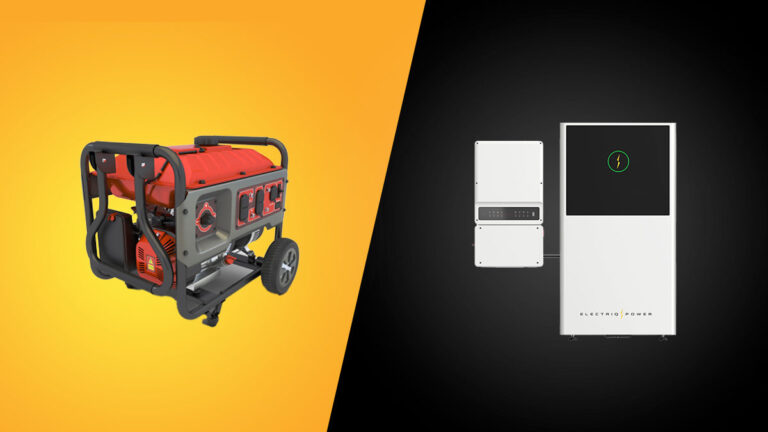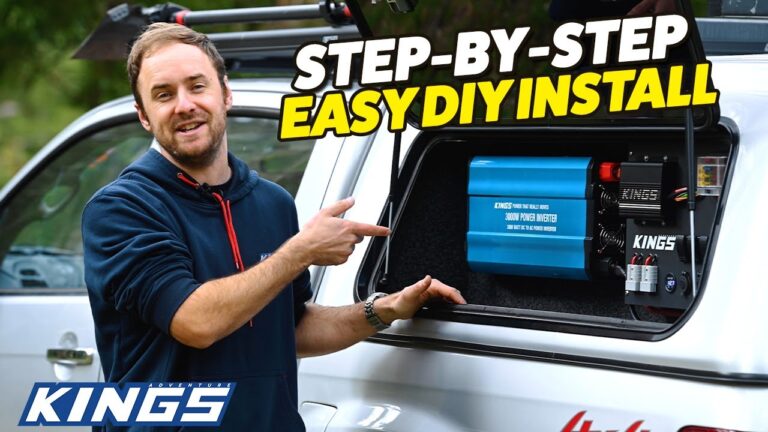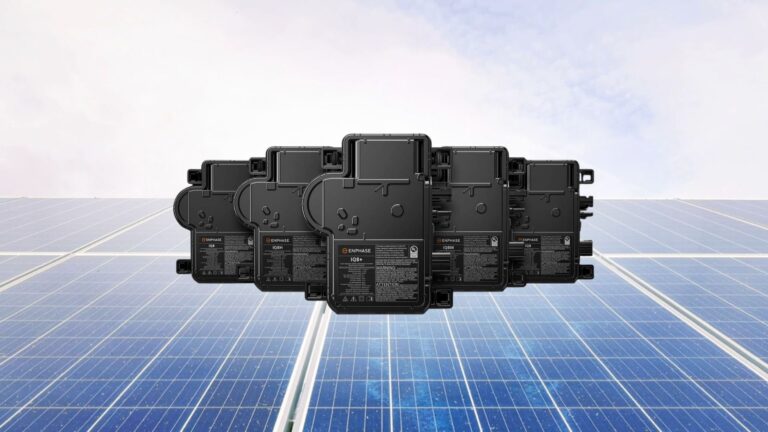Why Do You Need an Inverter for Solar Panels? Discover the Power Inside
An inverter for solar panels is necessary because it converts the direct current (DC) generated by the panels into usable alternating current (AC) for household appliances. Inverters play a crucial role in solar energy systems as they enable the captured sunlight to power common household devices.
Solar panels produce DC electricity, while most home appliances and the power grid operate on AC electricity. An inverter bridges this gap by converting the DC electricity from solar panels into AC electricity that can power everyday appliances. This conversion ensures that solar energy can be effectively utilized within a home or building, providing power for various electrical devices.
Inverters also allow excess solar energy to be fed back into the grid, helping to reduce energy costs and promoting sustainable energy practices. These capabilities make inverters an essential component of any solar panel system.
Understanding The Function Of Solar Inverters
Solar inverters play a crucial role in converting the direct current (DC) generated by solar panels into usable alternating current (AC) for powering household appliances. Without a solar inverter, the energy collected by the solar panels would be unusable, making the inverter an essential component for a functional solar energy system.
Solar inverters play a crucial role in ensuring the efficient operation of solar panels. By converting direct current (DC) electricity generated by solar panels into alternating current (AC) electricity, solar inverters enable the utilization of solar-generated power in our homes and businesses.
In this section, we will delve deeper into the specific functions and benefits that solar inverters offer.
Role Of Solar Inverters In Converting Dc To Ac Power
Solar inverters serve as the bridge between your solar panels and your electrical systems by converting the DC power generated by the panels into the AC power that your appliances and devices use. Here’s how solar inverters accomplish this conversion:
- Rectification: The solar inverter starts by rectifying the DC power produced by the solar panels, transforming it into a usable form.
- Power Conditioning: Once the DC power has been rectified, the inverter focuses on conditioning the power by smoothing out any irregularities and ensuring it meets the required standards for AC power.
- Inversion: The final step is the actual inversion process, where the inverter converts the conditioned DC power into AC power for use in your home or business.
Solar inverters are equipped with sophisticated electronics and control systems that ensure the conversion from DC to AC happens efficiently and accurately, allowing you to maximize the benefits of your solar panels.
How Solar Inverters Optimize Energy Production
Solar inverters go beyond the simple conversion of DC power to AC power. They also play a crucial role in optimizing energy production, ensuring that you get the most out of your solar panels. Here are some key ways in which solar inverters optimize energy production:
- Maximum Power Point Tracking (MPPT): Solar inverters utilize MPPT technology to continuously track and adjust the operating conditions of the solar panels, optimizing their performance and maximizing power output.
- Grid Interaction: Solar inverters enable the seamless integration of solar panels with the electrical grid. They allow excess power to be fed back into the grid, ensuring none of the energy goes to waste.
- Monitoring and Control: Advanced solar inverters come equipped with monitoring and control capabilities, allowing you to keep track of your system’s performance, identify any issues, and make necessary adjustments for optimal energy production.
- Safety Features: Solar inverters also have built-in safety features such as anti-islanding protection, which safeguards against power backflow into the grid during a power outage. This ensures the safety of utility workers fixing power lines and protects your solar investment.
By optimizing energy production, solar inverters help you generate more clean and renewable energy, reduce your reliance on traditional power sources, and potentially save on electricity bills.
Understanding the function and benefits of solar inverters is essential when considering the installation of solar panels. These devices not only convert DC to AC power but also optimize energy production, enabling you to harness the full potential of solar energy for your home or business.
With the right solar inverter, you can embrace sustainability, reduce your carbon footprint, and enjoy the long-term benefits of renewable energy.
Types Of Solar Inverters
Solar inverters are essential for converting the direct current (DC) electricity generated by solar panels into usable alternating current (AC) electricity. Without an inverter, solar panels would not be able to power household appliances or feed excess electricity back into the grid.
There are different types of solar inverters, such as string inverters, microinverters, and power optimizers, each offering unique benefits for solar energy systems.
When it comes to solar power systems, inverters play a crucial role in converting the direct current (DC) generated by solar panels into alternating current (AC) that can be used to power homes and businesses. There are several types of solar inverters available, each with its own unique features and advantages.
Let’s explore the three main types of solar inverters:
String Inverters:
- String inverters are the most commonly used type of solar inverters in residential and commercial applications.
- They work by connecting multiple solar panels in a series, creating a string of panels that generates DC electricity.
- The DC electricity generated by the string of panels is sent to the inverter, where it is converted into AC electricity.
- String inverters are cost-effective and easy to install, making them a popular choice among solar system owners.
- However, one drawback of string inverters is that the performance of the entire string can be affected if one panel in the string is underperforming or shaded.
Microinverters:
- Unlike string inverters, microinverters are installed on each individual solar panel.
- This means that each panel has its own dedicated inverter, allowing for independent operation.
- Microinverters offer several advantages, including increased system efficiency and performance.
- By having each panel operate independently, microinverters minimize the negative impact of shading or underperforming panels.
- Additionally, microinverters provide real-time monitoring capabilities, allowing system owners to easily track the performance of each panel.
Power Optimizers:
- Power optimizers are similar to microinverters in that they are installed on each panel.
- However, instead of converting DC to AC electricity like microinverters, power optimizers optimize the DC output from each panel before sending it to a central inverter.
- This configuration allows for individual panel optimization while using a central inverter to convert the optimized DC electricity to AC.
- Power optimizers offer the benefits of increased energy production and panel-level monitoring.
- They are particularly useful in situations where shading or different panel orientations are present.
Understanding the different types of solar inverters is essential when considering a solar power system. Whether you choose string inverters, microinverters, or power optimizers will depend on your specific needs and the characteristics of your installation. Make sure to consult with a professional solar installer to determine which type of inverter is best suited for your solar energy project.
Key Benefits Of Using Solar Inverters
Solar inverters are essential for converting the DC power produced by solar panels into AC power. They play a crucial role in maximizing energy efficiency and reducing electricity costs for solar systems, offering benefits such as grid independence, reduced carbon footprint, and potential cost savings.
Maximizing energy output from solar panels:
- Solar inverters play a crucial role in optimizing the energy output of solar panels. By converting the direct current (DC) generated by solar panels into usable alternating current (AC), inverters ensure that the maximum power generated by the panels is efficiently utilized.
- Inverters use MPPT (Maximum Power Point Tracking) technology to constantly monitor and adjust the voltage and current levels to extract the most power possible from the solar panels, even under varying weather conditions.
- This process helps to maximize the energy output, enabling you to generate more electricity from your solar system and reduce reliance on grid power.
Enhancing safety and reliability of solar systems:
- Solar inverters are equipped with essential safety features, such as ground fault protection and isolation, which safeguard your solar system from electrical surges and faults. These features ensure the safety of your property, appliances, and the people living in it.
- Inverters also contribute to the overall reliability of the solar system. They are designed to withstand harsh environmental conditions and provide stable operation, contributing to the long-term performance and durability of your solar panels.
- Furthermore, inverters protect your solar panels by preventing overloading and overheating, which can result in damage or reduced efficiency. With a reliable inverter, you can have peace of mind knowing that your solar system is functioning optimally.
Monitoring and managing solar energy production:
- Solar inverters offer real-time monitoring and management capabilities, allowing you to track the energy production of your solar panels. With advanced monitoring systems, you can have a clear view of how your system is performing, the amount of energy generated, and even identify any potential issues.
- Many inverters come with built-in or external monitoring tools that provide insights into daily, monthly, and yearly energy production. This information is valuable for evaluating the performance of your solar system and assessing the return on investment.
- By having access to comprehensive data on energy production, you can make informed decisions on energy usage, optimize your energy consumption, and potentially identify opportunities for further cost savings.
Solar inverters are crucial components of any solar system, offering key benefits such as maximizing energy output from solar panels, enhancing safety and reliability, and providing monitoring and management capabilities. By investing in a high-quality solar inverter, you can harness the full potential of your solar panels, ensure the long-term efficiency and performance of your system, and gain valuable insights into your energy production.
Factors To Consider When Selecting An Inverter
Selecting the right inverter for your solar panels involves considering factors like efficiency, power output, and compatibility. A well-chosen inverter ensures optimal performance and conversion of DC to AC power, maximizing your solar energy usage.
System size and capacity requirements:
- System size: Determine the size of your solar panel system to ensure the inverter can handle the load. Calculate the total wattage of your panels and choose an inverter with a capacity that matches or exceeds this amount.
- Capacity requirements: Consider the power requirements of your household or business. If you have high energy consumption, you may need a higher-capacity inverter to handle the load. Take into account future expansion plans that could increase your power needs.
Efficiency and performance of the inverter:
- Efficiency: Look for inverters with high efficiency ratings. Higher efficiency means less energy loss during the conversion process, leading to a more cost-effective solar system. Opt for inverters with efficiency ratings above 95%.
- Performance: Consider the inverter’s performance under different environmental conditions. Look for inverters that have a wide operating temperature range and are capable of performing well in extreme heat or cold. Check for features like temperature control and thermal protection.
Compatibility with solar panel technology:
- Technology compatibility: Check if the inverter is compatible with the type of solar panel technology you have installed. Some inverters are designed specifically for certain panel technologies like monocrystalline, polycrystalline, or thin-film. Ensure the inverter you choose is suitable for the technology you have.
- Inverter type: Decide between string inverters or microinverters. String inverters are cost-effective but have a centralized design, so if one panel underperforms, the whole system is affected. Microinverters, on the other hand, offer individual panel optimization and can maximize energy production, but they tend to be more expensive.
Considering these factors when selecting an inverter for your solar panel system will help ensure optimal performance, efficiency, and compatibility. Take the time to assess your system’s requirements and choose an inverter that meets your specific needs.
Evaluating Different Inverter Technologies
Solar panels require an inverter to convert the direct current (DC) produced by the panels into usable alternating current (AC) for your home or business. Evaluating different inverter technologies is crucial to ensure optimal energy efficiency and system performance. From string inverters to microinverters and power optimizers, understanding the benefits and limitations of each technology will help you make an informed decision for your solar energy system.
Today, solar panels are becoming increasingly popular as a sustainable energy option. However, to harness the full potential of solar energy, you need the right inverter technology. Inverters play a crucial role in converting the direct current (DC) generated by solar panels into usable alternating current (AC) for your everyday needs.
In this section, we will discuss the pros and cons of three prominent inverter technologies: string inverters, microinverters, and power optimizers.
Pros And Cons Of String Inverters:
- Cost-effective: String inverters are typically more affordable and easier to install compared to other technologies.
- Efficiency: They convert DC to AC efficiently when operating under optimal conditions.
- String-level monitoring: With string inverters, you can monitor the performance of your solar panels as a whole. This can help identify issues and improve maintenance.
- High voltage shutdown: In case of an emergency or maintenance, string inverters shut down the entire system, ensuring safety.
However, it’s important to be aware of the potential drawbacks:
- Single point of failure: As the entire solar array is connected to a single inverter, if one panel malfunctions, the entire system’s efficiency may be compromised.
- Shading issues: Shade on just one panel can affect the performance of the whole array, since they are connected in series.
Advantages And Disadvantages Of Microinverters:
Microinverters, as the name suggests, are installed on each individual solar panel. They offer several benefits over string inverters:
- Panel-level optimization: Microinverters optimize the output of each solar panel, maximizing energy production and overall system efficiency.
- Independent panel operation: Each panel operates independently, reducing the impact of shading or malfunctions on the rest of the array.
- Monitoring capabilities: With microinverters, you can monitor the performance of each panel separately, allowing for accurate troubleshooting.
However, there are a few drawbacks to consider:
- Higher initial cost: Microinverters tend to be more expensive than string inverters, as you need one for each panel.
- Complex installation: The installation process for microinverters can be more time-consuming and complex compared to string inverters.
Benefits And Limitations Of Power Optimizers:
Power optimizers offer a compromise between string inverters and microinverters. They provide certain advantages:
- Panel-level optimization: Similar to microinverters, power optimizers optimize the output of each panel, enhancing energy production.
- Shade tolerance: Power optimizers enable individual panels to perform better under partial shading conditions, unlike string inverters.
- String system compatibility: Power optimizers can also work with string inverters, combining the benefits of both technologies.
However, they also have some limitations:
- Added cost: Like microinverters, power optimizers increase the upfront cost of your solar system due to their individual installation requirement.
- Maintenance concerns: Since power optimizers are installed near the panels, they may be exposed to higher temperatures, potentially affecting their longevity.
Understanding the pros and cons of each inverter technology is essential in determining the best fit for your solar panel system. Whether you prioritize cost-efficiency, monitoring capabilities, shade tolerance, or energy optimization, make your decision based on your unique needs and budget.
Selecting An Inverter For Off-Grid Or Grid-Tied Systems
Selecting the right inverter is essential for both off-grid and grid-tied solar panel systems. An inverter is needed to convert the direct current (DC) electricity produced by solar panels into alternating current (AC) electricity that can be used in your home or fed back into the grid.
Make sure to choose an inverter that meets your specific system requirements for optimal performance.
Why Do You Need An Inverter For Solar Panels
Solar panels are an excellent investment for anyone looking to harness renewable energy and save on electricity bills. However, to fully utilize the power generated by the solar panels, you need an inverter. An inverter is an essential component of any solar panel system as it helps convert the direct current (DC) output from the panels into alternating current (AC) electricity that can be used to power your home or fed back into the grid.
In this blog post, we will explore the importance of selecting the right inverter for both off-grid and grid-tied solar systems.
Inverter Options For Off-Grid Solar Installations
For off-grid solar installations, where you are not connected to the utility grid, selecting the right inverter is crucial to ensure reliable and efficient power supply. Here are some key considerations when choosing an inverter for off-grid systems:
- Sine wave inverters: These are the most common type of inverters for off-grid solar systems. They produce a clean and stable sine wave output that is similar to the electricity supplied by the utility grid. Sine wave inverters are suitable for powering sensitive electronic devices without any risk of damage.
- Power capacity: Assess your power needs and choose an inverter with the appropriate power capacity. Oversizing the inverter can lead to wasted energy, while undersizing it may result in limited power supply.
- Battery compatibility: If you have battery storage in your off-grid system, ensure the inverter is compatible with the batteries you plan to use. This will enable efficient charging and discharging of the batteries.
- Multiple AC outlets: Consider an inverter that offers multiple AC outlets to conveniently power different appliances simultaneously.
- Monitoring capabilities: Opt for an inverter with monitoring capabilities, which provide real-time data on the system’s performance, helping you track energy production and diagnose any issues.
Inverters For Grid-Tied Solar Systems With Net Metering
Grid-tied solar systems with net metering allow you to offset your electricity consumption by feeding excess power back into the grid. When selecting an inverter for this type of system, here are some factors to consider:
- String inverters: String inverters are commonly used in grid-tied solar systems. They are cost-effective and convert the DC output from multiple solar panels wired in series into AC electricity. These inverters are ideal for residential installations.
- Microinverters: In contrast to string inverters, microinverters are installed on each individual solar panel, converting DC to AC at the panel level. This offers advantages such as increased system efficiency, shade tolerance, and individual panel monitoring.
- Power optimization: Power optimizers can be used in conjunction with string inverters to maximize power output in situations where shading or panel orientation might limit performance. They ensure that each panel operates at its maximum potential, improving overall system efficiency.
- Compliance with grid requirements: Ensure that the selected inverter meets the grid requirements and is compatible with your utility’s net metering program. Compliance ensures safe and seamless integration with the grid while maximizing energy production.
Remember, the choice of inverter for your solar panel system greatly impacts its performance and overall efficiency. By understanding the options available for both off-grid and grid-tied systems, you can make an informed decision to meet your energy needs effectively.
Identifying And Resolving Inverter Faults
An inverter is essential for solar panels as it helps convert the DC power generated by the panels into AC power for household use. However, identifying and resolving inverter faults is crucial to ensure optimal performance and maximize energy output from your solar system.
Expert troubleshooting can help uncover and fix any issues that may arise, preventing potential power disruptions.
Why Do You Need An Inverter For Solar Panels?
Solar panels are a great investment for renewable energy enthusiasts. They harness the power of the sun to generate electricity, making them an environmentally friendly option. However, to convert the direct current (DC) electricity produced by solar panels into usable alternating current (AC) electricity for your home or business, you need an inverter.
This vital component ensures that the energy generated by your solar panels can be utilized effectively. While inverters are crucial for a properly functioning solar system, they can encounter faults that may hinder their performance. In this section, we will explore common inverter error codes and their meanings, as well as troubleshooting steps for common inverter issues.
Common Inverter Error Codes And Their Meanings:
- E031: This error code indicates that there is an issue with the communication between the inverter and the monitoring system. It could be caused by a faulty communication cable or an error in the monitoring system software. Check the cable connections and update the monitoring system software if necessary.
- F002: This error code signifies that there is an insulation fault within the inverter. It could be due to damaged wiring or a defective component. Inspect the wiring for any signs of damage and replace any faulty components accordingly.
- E018: This error code indicates that there is a problem with the DC voltage of the solar panels. It could be caused by shading, dirt, or a faulty panel. Check for any obstructions or dirt on the panels, and ensure that they are functioning properly. If necessary, clean or replace the affected panels.
- F012: This error code suggests that there is an issue with the AC voltage of the inverter. It could be due to a faulty connection or an electrical problem in the grid. Check the AC connections and consult a professional electrician to resolve any issues with the grid.
Troubleshooting Steps For Common Inverter Issues:
- Check the display: Examine the inverter’s display to see if any error codes or warning messages are displayed. Note down the code or message for further troubleshooting.
- Restart the inverter: Sometimes, a simple restart can resolve minor issues. Turn off the inverter, wait for a few minutes, and then turn it back on. Observe if the error persists.
- Inspect the connections: Ensure that all the connections, including DC input, AC output, and communication cables, are securely plugged in. Loose connections can lead to errors or system malfunctions.
- Check for shading or obstructions: If you notice a decrease in the inverter’s performance, inspect the solar panels for shading or obstructions. Trim any overhanging branches or clear away any debris that may be blocking the sunlight.
- Clean the panels: Dust, dirt, or debris on the solar panels can affect their efficiency. Regularly clean the panels using a soft cloth or a gentle spray of water to maintain their optimal performance.
- Consult the user manual: Refer to the inverter’s user manual for specific troubleshooting steps or error code meanings. It may provide detailed instructions on how to resolve common issues.
- Seek professional assistance: If the troubleshooting steps mentioned above do not resolve the inverter’s issues, it is recommended to contact a professional solar installer or an electrician with experience in solar systems. They have the expertise to diagnose and fix more complex faults.
By understanding common inverter error codes and their meanings, as well as following the troubleshooting steps for common inverter issues, you can ensure the smooth functioning of your solar panel system. Regular maintenance, quick identification of faults, and prompt resolution can maximize the energy production and efficiency of your solar investment.
Maintaining And Extending The Lifespan Of Solar Inverters
Solar inverters are essential for extending the lifespan of solar panels by converting DC power into AC power. With their ability to optimize energy output and protect against damage, inverters play a crucial role in efficiently harnessing solar energy.
Solar inverters are an essential component of any solar power system. They convert the direct current (DC) electricity produced by solar panels into alternating current (AC) electricity that can be used to power our homes and businesses. While solar panels often steal the spotlight in terms of energy production, inverters play a crucial role in the system’s overall performance.
It is therefore important to understand the maintenance tasks required to ensure the optimal performance and longevity of solar inverters.
Regular Maintenance Tasks For Optimal Performance:
- Keep it squeaky clean: Regularly inspect your solar inverters for any dust, dirt, or debris. Clean them gently using a soft cloth or a brush to prevent buildup that could impede their performance.
- Check for loose connections: Periodically inspect the wiring connections on your inverters. Loose or corroded connections can lead to inefficient energy conversion or even failure of the system. Ensure all connections are tight and secure.
- Monitor performance: Stay vigilant about monitoring the performance of your solar inverters. Many modern inverters come with digital displays that show important data like energy production, voltage, and frequency. Regularly review this information to spot any abnormalities that may require attention.
- Keep an eye on heat dissipation: Solar inverters generate heat during operation. Make sure they are installed in a well-ventilated area or have proper cooling mechanisms in place. Excessive heat can reduce their efficiency and lead to premature failure.
Tips For Protecting Inverters From Environmental Factors:
- Shield from extreme temperatures: Extreme heat or cold can affect the performance and lifespan of solar inverters. If possible, install them in a shaded area or use a protective cover to shield them from direct sunlight or harsh weather conditions.
- Protect from moisture: Moisture is the nemesis of electronic equipment, and solar inverters are no exception. Ensure that they are protected from rain, snow, or any other sources of moisture. Properly seal any exposed areas to prevent water ingress.
- Beware of pests: Small animals, insects, or birds can find their way into electrical cabinets and cause damage or short circuits. Regularly inspect the surroundings of your inverters and take necessary measures to keep unwanted visitors away.
- Invest in surge protection: Power surges caused by lightning strikes or grid disturbances can wreak havoc on solar inverters. Install surge protectors to safeguard your inverters against sudden voltage spikes and ensure their longevity.
By performing regular maintenance tasks and implementing protective measures, you can significantly prolong the lifespan of your solar inverters. This not only maximizes their efficiency but also safeguards your investment in solar energy. Remember, a well-maintained inverter is key to harnessing the full potential of your solar power system.
Upgrading Or Replacing Solar Inverters
Solar inverters are essential components for solar panel systems, allowing them to convert sunlight into usable electricity. Whether you are upgrading or replacing your inverters, it is crucial to ensure they are in optimal condition to maximize your solar energy production.
Trusting the expertise of professionals can help you make the most of your solar investment.
Solar inverters are an essential component of any solar panel system. They convert the direct current (DC) produced by the solar panels into alternating current (AC) that can be used to power your home or business. While solar inverters are designed to last for many years, there may come a time when you need to upgrade or replace your inverter.
In this section, we will explore the signs that indicate it’s time for an upgrade or replacement, as well as the considerations you should keep in mind when upgrading to a more advanced inverter technology.
Signs That It’S Time To Upgrade Or Replace Your Inverter:
- System Age and Warranty Expiration: If your solar inverter is reaching the end of its warranty period or has been in operation for more than 10 years, it may be time to consider upgrading to a newer model. Older inverters are more prone to failures and may not be as efficient as newer, more advanced options.
- Decreased Performance: If you notice a significant decrease in the performance of your solar panel system, such as lower energy production or frequent fluctuations in power output, it could be a sign of an inverter issue. Upgrading or replacing your inverter can help restore the system’s overall performance and energy production.
- Inverter Failures: If your current inverter has experienced multiple failures or requires frequent repairs, it might be a clear indication of the need for an upgrade. Investing in a more reliable and technologically advanced inverter can save you from the hassle and costs of continuous repairs.
- Advancements in Technology: Solar inverter technology has come a long way in recent years, with advancements such as improved efficiency, higher power density, and enhanced monitoring capabilities. Upgrading to a more advanced inverter can harness these technological advancements, leading to increased energy production and better overall system performance.
- System Expansion: If you plan to expand your solar panel system, it’s crucial to assess whether your existing inverter can accommodate the increased capacity. In some cases, adding more panels may require upgrading your inverter to handle the higher power output effectively.
Considerations When Upgrading To A More Advanced Inverter Technology:
- Compatibility: Ensure that the new inverter you choose is compatible with your existing solar panel system. Consider factors such as voltage requirements, system size, and configuration to ensure a seamless integration.
- Efficiency and Power Output: Assess the efficiency and power output of potential inverters to determine if they align with your energy production goals. Higher efficiency inverters can maximize the energy harvested from your solar panels, resulting in greater cost savings over time.
- Monitoring and Data Analysis: Look for inverters that offer advanced monitoring and data analysis capabilities. These features provide real-time insights into your system’s performance, allowing you to identify any issues promptly and optimize energy generation.
- Warranty and Support: Consider the warranty period and available support services offered by the inverter manufacturer. Opting for a reputable brand with a solid warranty ensures peace of mind and assistance in case of any unforeseen issues.
- Budget and Return on Investment: Evaluate the upfront cost of the new inverter alongside the potential long-term savings it can provide. Calculating the return on investment (ROI) will help you make an informed decision based on your budget and expected financial benefits.
Upgrading or replacing your solar inverter can have a significant impact on the overall performance, efficiency, and longevity of your solar panel system. By paying attention to the signs that indicate the need for an upgrade and considering the relevant factors when selecting a more advanced inverter, you can ensure that your solar energy system operates at its best and maximizes your renewable energy potential.

Credit: www.bloomberg.com
What Is the Role of an Inverter in Solar Panel Systems?
An inverter is a crucial component of solar panel systems. It converts the direct current (DC) electricity generated by the panels into alternating current (AC) electricity which is suitable for use in residential or commercial buildings. In other words, it transforms the power produced by the solar panels into a form that can be easily utilized to power appliances and meet the electricity needs of a property. So, what is an inverter? It is the element responsible for converting solar energy into usable electricity.
Frequently Asked Questions For Why Do You Need An Inverter For Solar Panels
Can Solar Panels Work Without An Inverter?
Solar panels cannot work without an inverter. The inverter is an essential component that converts the direct current (DC) produced by the solar panels into alternating current (AC) that can be used to power our homes and businesses. The inverter ensures that the electricity generated by the solar panels is compatible with the electrical grid and can be used to power appliances and electronics.
Essentially, it acts as a bridge between the solar panels and the electrical system in our buildings. Without an inverter, the energy produced by the solar panels would be unusable and not compatible with our electrical devices. So, if you want to harness the power of solar energy, an inverter is a crucial component that cannot be omitted.
What Are The Disadvantages Of Solar Inverter?
Solar inverters have a few disadvantages that should be taken into consideration. Firstly, they require an additional upfront cost to install, which can be a disadvantage for those on a tight budget. Secondly, solar inverters are prone to inefficiency due to varying weather conditions and shading.
This can result in reduced power output and therefore, lower energy savings. Moreover, solar inverters are not currently capable of storing excess energy for later use. As a result, any surplus energy generated during the day that is not used is wasted.
Lastly, solar inverters have a limited lifespan and may require replacement or maintenance over time. It is important to consider these potential drawbacks when assessing the feasibility of installing a solar inverter system. Keeping these factors in mind, solar inverters can still be a beneficial and environmentally friendly choice for renewable energy generation.
Is It Necessary To Have An Inverter?
Yes, having an inverter is necessary for certain situations. An inverter converts DC power from a battery into AC power that can be used to run appliances and devices. If you rely on battery power, such as during power outages or when camping, an inverter allows you to use standard electrical devices.
It also enables you to charge electronics that require AC power. Additionally, inverters are essential for solar panel systems, as they convert the DC power generated by the panels into usable AC power for your home or business. Inverters come in various sizes and capacities to suit different needs.
Overall, having an inverter ensures that you can access power from batteries or alternative energy sources, making it an essential component in many cases.
Are Solar Inverters Worth It?
Solar inverters are definitely worth the investment. They convert DC power generated by solar panels into AC power, which is what most of our household appliances use. By using solar inverters, you can harness the power of the sun and reduce your reliance on traditional energy sources.
Solar inverters also help in saving on your electricity bills and reduce carbon emissions. Plus, they come with warranties and are built to last. In the long run, the savings on electricity bills can offset the initial cost. Additionally, solar inverters require minimal maintenance, making them a hassle-free option.
Going solar with inverters is a smart move from both an environmental and financial standpoint. So, embrace the power of solar energy with solar inverters and start saving money today.
Conclusion
Finally, it is clear that investing in an inverter for solar panels is a wise decision. Not only does it convert the DC power generated by the panels into AC power, but it also ensures the efficiency and reliability of the entire solar system.
By providing a stable power supply, an inverter maximizes the energy harvested from the sun and minimizes energy loss. This translates into significant cost savings for homeowners and businesses, as the energy produced can be used directly or sold back to the grid.
Moreover, modern inverters come equipped with advanced features such as monitoring systems, remote control capabilities, and smart technology integration, making them a user-friendly and convenient choice. So, whether you are considering going solar for financial reasons, environmental concerns, or energy independence, an inverter is essential to harness the full potential of your solar panels and enjoy the numerous benefits they offer.
Take the first step towards a greener future and invest in an inverter for your solar system today.

